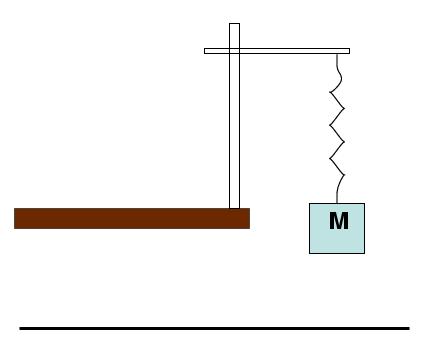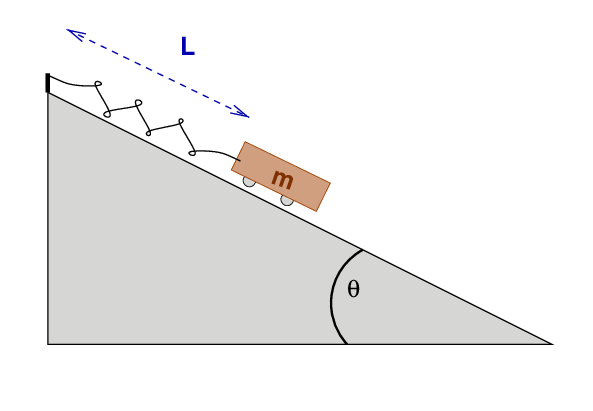The force exerted by a spring
If you try to stretch a spring, it will pull back against
you.
The farther you stretch the spring,
the harder it pulls back.
Can you make this simple description more quantitative?

Students who are in class ...
- Acquire one small silver spring. Measure its mass and its
length as it lies horizontally at rest on the table.
- Arrange clamps and bars as shown in the diagram above so that you
can hang the spring from a horizontal bar.
Measure the length of the spring as it hangs by itself;
call this L0.
- Place 7 various weights, ranging from 0 to 150 grams, on the
bottom of the spring. Measure the length
of the spring for each case.
Compute the distance the spring has stretched
from L0.
Include uncertainties in this "distance stretched".
- Calculate the force exerted by the spring in each case.
Make a neat table of all your measurements and calculations.
Students who are remote ...
While your partners in the classroom measure a real spring,
you can practice performing the calculations and making the graphs.
Pretend that the following data file contains your group's
actual measurements:
- Using the fake data,
compute the distance the spring has stretched
from L0.
Include uncertainties in this "distance stretched".
- Calculate the force exerted by the spring in each case.
Make a neat table of all your measurements and calculations.
- Make a graph which shows force exerted by the spring
as a function of the distance by which the spring
has been stretched.
- The graph should show a (nearly) straight line.
Compute the slope of this line,
together with an uncertainty.
- Use the slope (and uncertainty) to calculate the force constant
(and uncertainty) of the fake spring.
Convert your values to Newtons per meter.
Everyone working together
When the students in class have completed their measurements,
share them with the remote group.
Everyone should now use these measurements to
determine the force constant of the real spring,
together with an uncertainty.
- Use a graph of the REAL data
to compute the "spring constant" or "force constant"
of your spring. Include uncertainties, and make
sure the units of your values make sense.
- Walk around and talk to at least 3 other groups.
Write down their spring constants (with uncertainties)
and compare them to yours.
Are all the springs in class today "identical"?
Prediction
At the center table, I will set up a track
tilted at 15 degrees.
We will attach your spring to the track so that it
lies along the track,
and then attach to the lower end
a cart of mass m (I'll provide the
actual mass during the class period).

How long will your spring be when it comes
to rest, supporting the car on this tilted track?
Make a prediction.
If your prediction is your score for
within this part will be
------------------------------------------
+/- 2 cm +3
+/- 4 cm +2
+/- 6 cm +1
------------------------------------------


